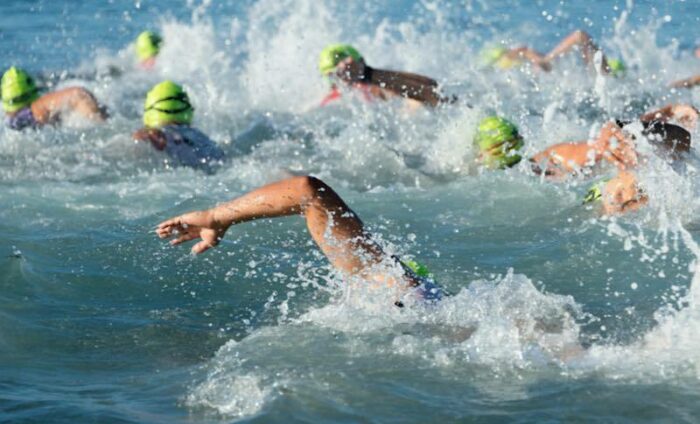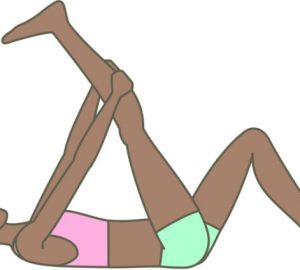
“I just get so nervous; my breathing goes into overdrive and I don’t know what to do”
Sport psychology consultant Helen Davis outlines some strategies to tackle anxiety when racing
You have just started a race and it’s chaos. Flailing limbs inadvertently hit you, arms are pounding on top of you and you are unable to get into a rhythm. You turn to breathe and get a face full of water and a whack on the head. Your wetsuit suddenly feels tight and your heart is thumping. This kind of experience can be unpleasant, yet common in open water swimming events and even experienced swimmers can find themselves grinding to a panic-stricken halt, unable to pinpoint the cause of their anxiety.
What is causing your stress?
Knowing what is causing your stress is the first step to overcoming your anxiety. “That’s easy,” swimmers will commonly say “it’s the washing machine start that stresses me out” or “I worry about people swimming on top of me,” but is this really the case?
Stress is the result of HOW you respond to a certain situation. That is, it is not the situation itself that is causing your stress, it is your interpretation of it. Stress is an ongoing process of assessing our environment, our stressors and our attempts to cope with situations as they arise. If you perceive an imbalance between the demands of your environment and your coping resources, then you will have an anxiety response. This response can vary between situations and sometimes in the same situation at different times, hence even experienced competitors are not immune to the odd bout of anxiety.
How to respond
Symptoms of anxiety, even uncomfortable ones, are not necessarily detrimental to performance. Indeed, the difference between elite and amateur competitors lies not in the intensity of their competition anxiety, but the extent to which they consider that anxiety debilitative or facilitative to performance. Amateur athletes tend to tackle anxiety using strategies aimed at lowering the intensity of their response, such as relaxation, whereas elite athletes are more likely to use psychological techniques to interpret their anxiety response as facilitative to performance.
Here are some strategies to tackle anxiety by lowering intensity of response and psychological techniques to help you manage your emotions and keep swimming
PSYCHOLOGICAL TECHNIQUES
Physical preparation
Mimic the chaos of an open water start in training and aim to practise in your wetsuit as much as you can. Reminding yourself of your physical practice and preparation can give you a psychological boost. Just knowing that you have experience to draw upon can help you cope if you find yourself in a challenging situation.
Positive self-talk
Use positive self-talk to get your mind in good shape for swimming in difficult conditions. Firstly, get in control: remind yourself of your skills, knowledge and experience that you have and can use every day to help you cope. Next, make plans to keep your priorities clear and your focus sharp. Remind yourself of times you have performed in tough conditions before, as this will help boost your confidence for coping again. Finally, decide what attitude you want to keep focused on to help you enjoy this challenging situation – knowing how you want to test yourself and learning from a situation will put you more in control.
Compose a strategy
Having a performance routine prior to swimming in challenging conditions will help to maximise your readiness and confidence before you perform. Routines are key to consistently good performances under pressure. A routine helps you be mentally ready (so your mind is calm and focused on what’s helpful) and physically ready (your body is ready to do what it needs). Practising your routine is essential if you want it to work for you when the heat is on. What is the best plan for you? Try it out, see how it works. Tweak and improve it until it’s doing what it should do.
Use imagery
See yourself performing well in a challenging open water environment. Picture yourself executing your strategy or escape plan when difficulties arise. Practise saying trigger words or phrases that can help you focus on what you need to do in those moments. Practising this imagery and seeing yourself coping and dealing with the situation can make a difference. Try it and see!
LOWERING INTENSITY
Breathing techniques
Recognise that breathing is the most important part of swimming and when it is not going well, it can trigger hyperventilating, anxiety and panic. Cold water hitting your face may cause you to hold your breath and may make it hard to exhale fully in the water, so a warm up swim is a good idea to get used to the temperature. Learn to breathe in a variety of patterns (every 2, 3, or 4 strokes) and feel comfortable using these patterns in different situations. Train yourself to reset your breathing by going more slowly, taking a few deep, clearing breaths or stopping long enough to get your breathing back to normal.
Escape plan
Have an ‘escape plan’ if things are not going well. If you swallow water, are coughing, feeling anxious or panicky, stop swimming, roll onto your back to make breathing easier and work at calming your breathing down (eg.. repeatedly breathe in for a count of 4, out for a count of 7). Adopt a position that you can practise beforehand that you call your ‘escape place.’ If you can resume your swim, do so at a pace that is comfortable and manageable.
Helen Davis is a swimmer and sport psychology consultant who works with individuals, teams and coaches on their sporting performance. Each month, Helen will suggest psychological techniques to help overcome difficult open water swimming scenarios.
@helenDav2245









